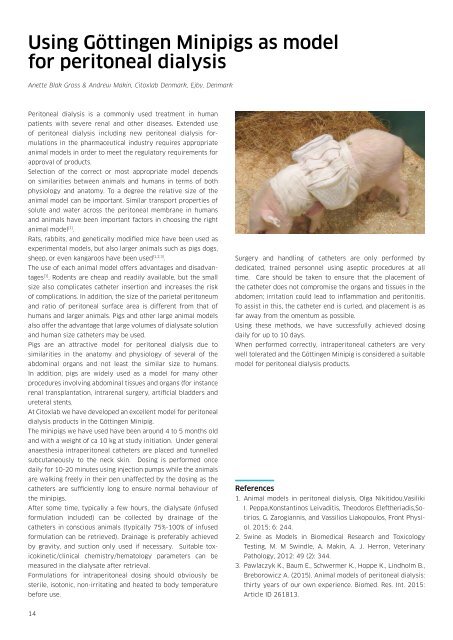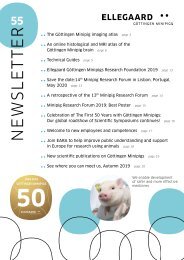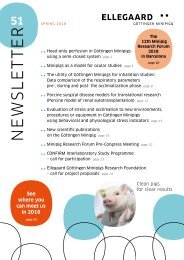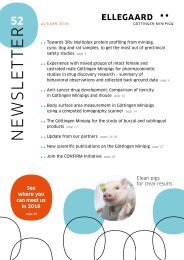Create successful ePaper yourself
Turn your PDF publications into a flip-book with our unique Google optimized e-Paper software.
Using <strong>Göttingen</strong> <strong>Minipigs</strong> as model<br />
for peritoneal dialysis<br />
Anette Blak Gross & Andrew Makin, Citoxlab Denmark, Ejby, Denmark<br />
Peritoneal dialysis is a commonly used treatment in human<br />
patients with severe renal and other diseases. Extended use<br />
of peritoneal dialysis including new peritoneal dialysis formulations<br />
in the pharmaceutical industry requires appropriate<br />
animal models in order to meet the regulatory requirements for<br />
approval of products.<br />
Selection of the correct or most appropriate model depends<br />
on similarities between animals and humans in terms of both<br />
physiology and anatomy. To a degree the relative size of the<br />
animal model can be important. Similar transport properties of<br />
solute and water across the peritoneal membrane in humans<br />
and animals have been important factors in choosing the right<br />
animal model [1] .<br />
Rats, rabbits, and genetically modified mice have been used as<br />
experimental models, but also larger animals such as pigs dogs,<br />
sheep, or even kangaroos have been used [1,2,3] .<br />
The use of each animal model offers advantages and disadvantages<br />
[1] . Rodents are cheap and readily available, but the small<br />
size also complicates catheter insertion and increases the risk<br />
of complications. In addition, the size of the parietal peritoneum<br />
and ratio of peritoneal surface area is different from that of<br />
humans and larger animals. Pigs and other large animal models<br />
also offer the advantage that large volumes of dialysate solution<br />
and human size catheters may be used.<br />
Pigs are an attractive model for peritoneal dialysis due to<br />
similarities in the anatomy and physiology of several of the<br />
abdominal organs and not least the similar size to humans.<br />
In addition, pigs are widely used as a model for many other<br />
procedures involving abdominal tissues and organs (for instance<br />
renal transplantation, intrarenal surgery, artificial bladders and<br />
ureteral stents.<br />
At Citoxlab we have developed an excellent model for peritoneal<br />
dialysis products in the <strong>Göttingen</strong> Minipig.<br />
The minipigs we have used have been around 4 to 5 months old<br />
and with a weight of ca 10 kg at study initiation. Under general<br />
anaesthesia intraperitoneal catheters are placed and tunnelled<br />
subcutaneously to the neck skin. Dosing is performed once<br />
daily for 10-20 minutes using injection pumps while the animals<br />
are walking freely in their pen unaffected by the dosing as the<br />
catheters are sufficiently long to ensure normal behaviour of<br />
the minipigs.<br />
After some time, typically a few hours, the dialysate (infused<br />
formulation included) can be collected by drainage of the<br />
catheters in conscious animals (typically 75%-100% of infused<br />
formulation can be retrieved). Drainage is preferably achieved<br />
by gravity, and suction only used if necessary. Suitable toxicokinetic/clinical<br />
chemistry/hematology parameters can be<br />
measured in the dialysate after retrieval.<br />
Formulations for intraperitoneal dosing should obviously be<br />
sterile, isotonic, non-irritating and heated to body temperature<br />
before use.<br />
Surgery and handling of catheters are only performed by<br />
dedicated, trained personnel using aseptic procedures at all<br />
time. Care should be taken to ensure that the placement of<br />
the catheter does not compromise the organs and tissues in the<br />
abdomen; irritation could lead to inflammation and peritonitis.<br />
To assist in this, the catheter end is curled, and placement is as<br />
far away from the omentum as possible.<br />
Using these methods, we have successfully achieved dosing<br />
daily for up to 10 days.<br />
When performed correctly, intraperitoneal catheters are very<br />
well tolerated and the <strong>Göttingen</strong> Minipig is considered a suitable<br />
model for peritoneal dialysis products.<br />
References<br />
1. Animal models in peritoneal dialysis, Olga Nikitidou,Vasiliki<br />
I. Peppa,Konstantinos Leivaditis, Theodoros Eleftheriadis,Sotirios,<br />
G. Zarogiannis, and Vassilios Liakopoulos, Front Physiol.<br />
2015; 6: 244.<br />
2. Swine as Models in Biomedical Research and Toxicology<br />
Testing, M. M Swindle, A. Makin, A. J. Herron, Veterinary<br />
Pathology, 2012: 49 (2): 344.<br />
3. Pawlaczyk K., Baum E., Schwermer K., Hoppe K., Lindholm B.,<br />
Breborowicz A. (2015). Animal models of peritoneal dialysis:<br />
thirty years of our own experience. Biomed. Res. Int. 2015:<br />
Article ID 261813.<br />
14








